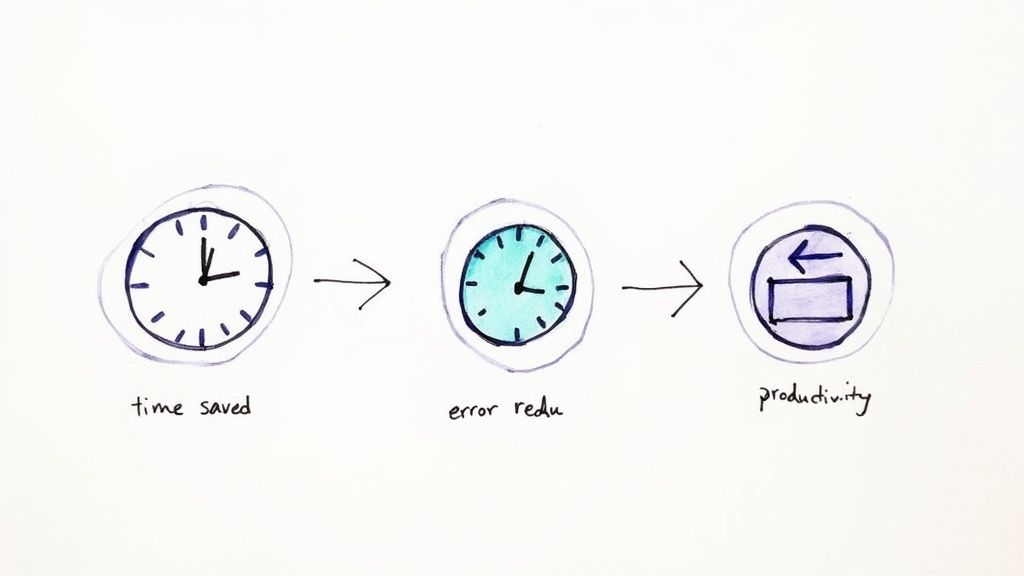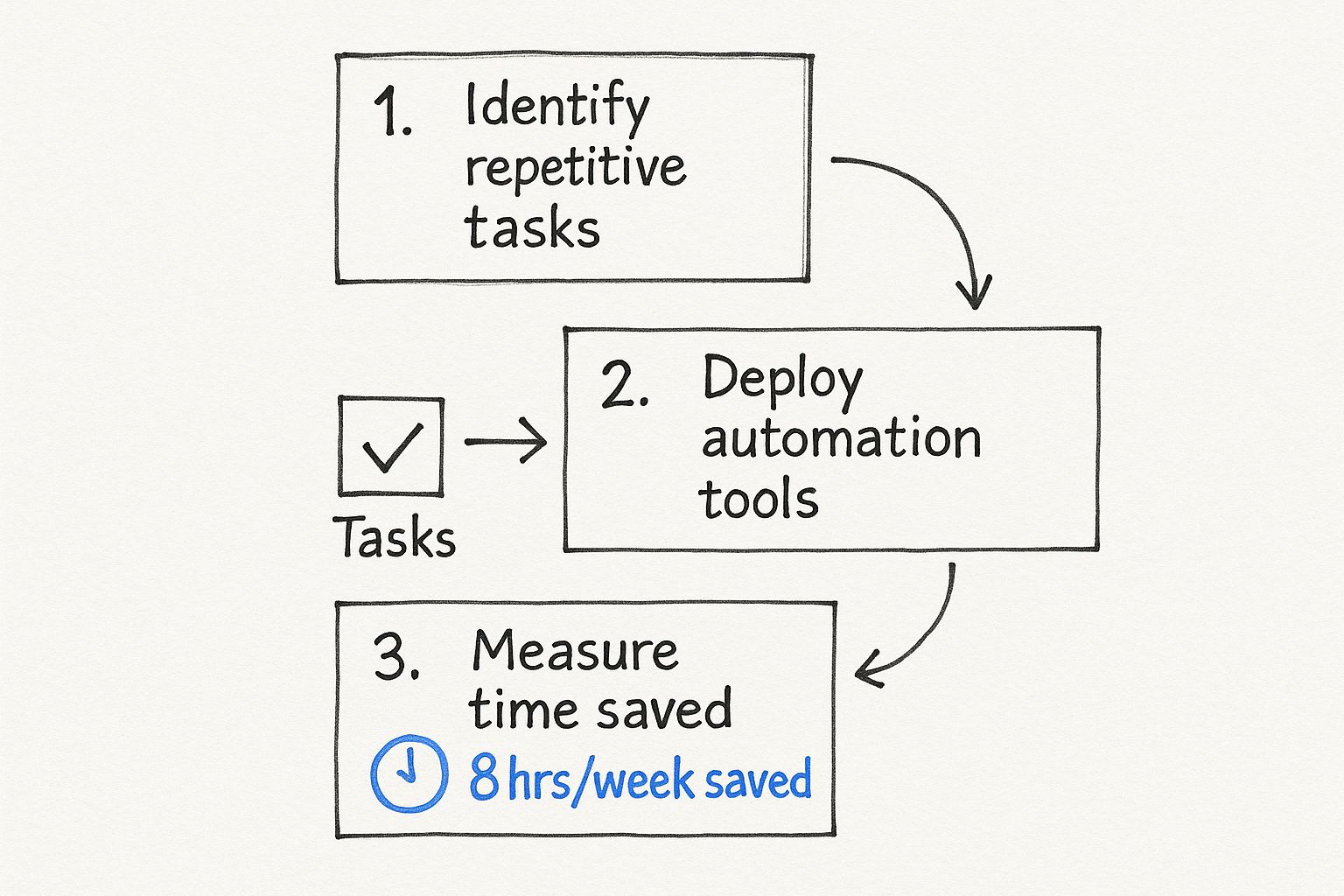
Workflow Automation For Small Business: The Complete Guide
Master workflow automation for small business with proven strategies. Get actionable insights from successful owners using automation to scale efficiently.

Why Workflow Automation Has Become A Small Business Survival Tool
Let's talk about Maria. She owns a boutique marketing agency. Three years ago, she was drowning in a sea of client requests, invoices, and those dreaded late-night emails. Fast forward to today, and a different picture emerges. Automated systems handle her routine tasks, freeing Maria to focus on what really matters: growing her business. The result? Her revenue has tripled.
This isn't just a feel-good anecdote. It's a reflection of a larger trend. Thousands of small businesses are discovering that workflow automation isn't a luxury—it's essential for survival.
Think of it this way: in today's competitive market, clinging to manual processes is like trying to run a marathon in lead boots. Businesses that embrace automation, however, are building a competitive edge. They're creating a "moat" around their business, one that even larger companies struggle to cross. How? By freeing up time and resources to focus on innovation and building strong customer relationships.
The Rise of Workflow Management Software
This shift towards automation is clearly visible in the growing adoption of workflow management software. These tools streamline operations, cut down on manual tasks, and help businesses scale more efficiently. They also minimize human error and free up resources for vital activities like strategic planning and customer engagement. By 2025, small businesses are increasingly relying on these tools to boost productivity and stay competitive. Learn more about workflow automation trends here.
Automation isn't just about improving operations; it's about a fundamental change in mindset. When routine tasks are automated, business owners like Maria gain peace of mind. Instead of constantly putting out fires, they can focus on the bigger picture.
This shift leads to happier employees, more satisfied customers, and a business that runs smoothly, even when the owner isn't there. This proactive approach separates businesses that thrive from those just barely getting by. Maria's story, and countless others like hers, demonstrate why embracing automation early on is a key ingredient for long-term success.
Demystifying Workflow Automation For Real Business Owners

Let's ditch the tech talk and discuss workflow automation for small businesses in plain English. Think of it as having an incredibly reliable assistant who never takes breaks, never forgets a task, and works 24/7. That's the power of workflow automation. It's like setting up a chain reaction, where completing one task automatically triggers the next.
For example, imagine a customer fills out a contact form on your website. This simple action can automatically set off a series of events: adding them to your CRM system, sending a personalized welcome email, scheduling a follow-up with your sales team, and even updating your dashboard. All this happens seamlessly, without any manual intervention. This orchestrated flow is what we call workflow orchestration.
Beyond Simple Task Automation
Workflow automation is more than just scheduling social media posts. While task automation handles individual actions, true workflow orchestration manages entire processes, from customer journeys to internal operations. Think of it this way: scheduling a single tweet is task automation, while automatically nurturing a lead from initial contact to final sale is workflow orchestration.
This means you can pinpoint those daily frustrations and transform them into opportunities for automation. Consider the repetitive tasks that consume your time and energy. Which ones truly require your personal touch, and which could be handled by a "digital assistant"? Maintaining genuine human connection with your customers is crucial, but automating repetitive processes frees you to focus on those high-touch interactions.
To understand how other small businesses are integrating AI into their workflows, take a look at this helpful resource: Implementing AI in Small Businesses. This empowers you to provide personalized service where it truly counts. Streamlining your operations gives you more time to build relationships and focus on growing your business.
Let's look at a practical comparison to really illustrate the benefits of automation.
To help visualize the advantages, let's explore a comparison of manual versus automated workflows. The table below highlights the key differences in time, cost, and accuracy.
Manual vs. Automated Workflow Comparison
| Process Type | Manual Approach | Automated Approach | Time Saved | Error Reduction |
|---|---|---|---|---|
| Customer Onboarding | Manually entering customer data, sending welcome emails, scheduling follow-ups | Automated data entry, email sequences, and follow-up scheduling | 50-75% | 90% |
| Order Fulfillment | Manually processing orders, updating inventory, generating shipping labels | Automated order processing, inventory updates, and label generation | 60-80% | 85% |
| Social Media Management | Manually scheduling posts across platforms | Automated scheduling and content distribution | 40-60% | N/A |
| Report Generation | Manually compiling data and creating reports | Automated data gathering and report creation | 70-90% | 95% |
As you can see, automating key workflows can significantly reduce the time spent on repetitive tasks, allowing you to focus on more strategic initiatives. Furthermore, automation drastically minimizes the risk of human error, leading to improved accuracy and efficiency. By freeing up your time and improving accuracy, you can focus on what truly matters: building your business and nurturing customer relationships.
The Transformation That Actually Happens In Your Business

The biggest impact of workflow automation for a small business often isn't the boost to efficiency, but the mental shift it creates. Think of it like this: imagine Sarah, a small business owner drowning in paperwork. She automates her client onboarding process. Suddenly, she's not just saving eight hours a week, she's sleeping through the night. No more 3 AM panic about forgotten documents. That transition, from reactive to proactive, from scattered to strategic, is the real power of automation.
From Firefighting To Forward-Thinking
After six months of using automation, many business owners report a similar change. They're not constantly putting out fires anymore. They can actually plan for the future. And this shift has a ripple effect.
- Employees are happier, focusing on meaningful work instead of tedious admin.
- Customers are more satisfied because they receive consistent, timely service.
- Owners finally have the mental space to strategize, innovate, and truly grow their business.
This newfound clarity is especially important for small business owners who often wear many hats. Automation lets them delegate routine tasks, freeing up time and energy for bigger-picture thinking.
Another key benefit of workflow automation is its impact on productivity and efficiency. Think about this: 51% of employees spend at least two hours every day on repetitive tasks. These are tasks that could be automated! By automating them, businesses free up huge chunks of time for more strategic and creative work. This boosts employee morale and leads to smoother teamwork and increased output. What's more, about 31% of businesses have already automated at least one function, showing a clear move toward optimizing processes. This trend will likely continue as more businesses realize the advantages of automation. Discover more insights on workflow automation statistics.
The Unexpected Perks of Automation
Beyond the obvious time-saving benefits, automation offers hidden advantages. Real-time process updates, for example, improve team communication. Everyone's on the same page. And knowing your business can run without your constant supervision is incredibly empowering.
This allows owners to step back, delegate effectively, and focus on high-level decisions. In the end, workflow automation helps small businesses not just survive, but truly thrive. It's about moving from constantly reacting to proactively growing. This shift creates a solid base for long-term stability and helps businesses adapt to changing market conditions.
Proven Automation Strategies That Drive Real Results
Feeling lost when it comes to workflow automation for your small business? You're not alone. Let's ditch the confusion and explore some practical strategies that other successful small businesses are already using.
Think about your customer onboarding process. Right now, you might be manually sending welcome emails, setting up accounts, and sending instructions. What if, instead, a system automatically took care of all that?
Imagine a personalized welcome sequence triggered the moment a new client signs up. This could include a welcome message, instant access to your client portal, calendar invites for kickoff meetings, and even automated reminders about next steps. All while you focus on what you do best: delivering your core services.
Automating Key Business Functions
Inventory management is another area ripe for automation. Picture this: you set automated reorder points that trigger purchase orders before you run out of stock. No more last-minute scrambles to fulfill orders, just smooth sailing. These are just a couple of examples of how workflow automation can reshape your business.
- Lead Nurturing: Automated email sequences can nurture leads and convert them into paying customers, even while you're sleeping.
- Appointment Reminders: Automated reminders can drastically reduce no-shows. Some businesses have seen a 70% decrease after implementing this simple automation.
- Financial Workflows: Think organized books without the manual data entry. Automation can make it happen.
Each of these strategies addresses a specific business challenge and offers a clear path to implementation. For more tips on improving efficiency, check out this article on improving workflow efficiency. We'll also look at realistic timelines for seeing tangible results.
Prioritizing Your Automation Efforts
The secret to successful workflow automation for small businesses isn't about automating everything at once. It's about prioritizing. Start by identifying your biggest pain points and then matching them to the resources you have available.
Ask yourself these questions: Which workflows will have the most significant impact on your business? Which ones are the easiest and quickest to implement?
Focusing on these high-impact, low-effort workflows first will give you quick wins and build momentum. These early successes also demonstrate the value of automation to your team, making it easier to get everyone on board and smoothing the transition. Remember, workflow automation isn't just about saving time; it's about optimizing your entire operation.
To help you prioritize, let's look at some common automation opportunities:
Let's look at some common opportunities for automation in small businesses. The table below outlines some key areas you can automate, ranked by their potential impact and ease of implementation. It also provides estimated ROI and time-to-results to give you a clearer picture.
Top Small Business Automation Opportunities
| Business Function | Automation Opportunity | Implementation Difficulty | Expected ROI | Time to Results |
|---|---|---|---|---|
| Customer Onboarding | Automated welcome emails, client portal access, kickoff meeting scheduling | Easy | High | Weeks |
| Inventory Management | Automated reorder points, purchase order generation | Medium | High | 1-2 Months |
| Lead Nurturing | Automated email sequences, lead scoring | Medium | Medium | 2-3 Months |
| Appointment Reminders | Automated SMS or email reminders | Easy | Medium | Weeks |
| Financial Workflows | Automated invoice generation, expense tracking | Medium | High | 2-3 Months |
| Social Media Marketing | Automated post scheduling, social listening | Easy | Medium | 1-2 Months |
| Customer Support | Automated responses to common queries, chatbot integration | Medium | Medium | 2-3 Months |
This table provides a starting point for your automation journey. Remember to adapt it to your specific business needs and priorities.
By focusing on the areas with the highest potential impact and shortest time to results, you can quickly start seeing the benefits of automation and build a foundation for more complex projects down the line.
Finding The Right Tools Without Overspending

The sheer number of workflow automation tools available can feel a bit like stepping into a crowded marketplace. There are thousands of options, with prices ranging from free to eye-wateringly expensive enterprise solutions. So how do you navigate this and find what truly works for your small business?
Surprisingly, you can accomplish a lot with free tools. Think about the power of something like Zapier's basic plan or even the automation capabilities built into Google Workspace. These options can handle a significant chunk of your workflow needs without costing you a dime. You might also find our guide on Google Workspace productivity tools helpful in exploring these options. This lets you dip your toes into the automation waters without a major upfront investment.
Exploring Premium Platforms
Free tools are excellent for getting started, but eventually, you might bump up against their limitations and need more horsepower. That's where premium platforms enter the picture.
Tools like Tooling Studio bring advanced automation within reach for small businesses. They offer features you often won't find in free tools, such as the ability to create custom integrations and build more complex workflow logic. Think of it as bridging the gap between basic automation and the powerful solutions typically reserved for much larger companies.
Key Questions For Tool Evaluation
Choosing the right automation tools isn't just about the price tag. It's about finding the right fit for your business. Here are a few key questions to consider:
- Integration: Does the tool play nicely with the systems you already use? A tool that doesn't connect to your CRM or email marketing platform can actually create more headaches than it solves. Seamless integration is vital for efficient data flow and prevents information from getting trapped in silos.
- Learning Curve: How easy is the tool to pick up and use? A complex tool with a steep learning curve might require substantial training and could face resistance from your team.
- Vendor Lock-in: What happens to your carefully crafted workflows if you decide to switch providers down the road? Make sure you can easily export your data and workflows to avoid getting stuck with a vendor that no longer meets your needs.
Hidden Costs To Consider
Beyond the initial price, there can be other costs lurking beneath the surface. These hidden costs can significantly impact your budget, so it's important to factor them in:
- Setup Time: Implementing any new tool requires time and effort. Consider the hours needed for configuration, testing, and training your team.
- Training Requirements: Complex tools often require specialized training, which adds to the overall cost.
- Ongoing Maintenance: Don't forget about ongoing subscription fees, support costs, and potential expenses for future upgrades.
Successfully implementing workflow automation also means considering how it specifically applies to different areas of your business, like sales. For example, you can delve deeper into optimizing your sales workflows by checking out resources like this guide on sales process automation.
By carefully evaluating these factors, you can choose tools that not only meet your current needs but also support your future growth. Building a scalable automation foundation ensures your systems can adapt as your business expands. This proactive approach empowers you to make informed decisions that maximize your return on investment and avoid unexpected costs down the line.
Your Complete Implementation Roadmap
Ready to make workflow automation a reality for your small business? This isn't just a theoretical discussion; it's a practical guide used by successful business owners. Think of it like mapping out a road trip – you wouldn't just jump in the car and start driving, would you?
First, conduct an "automation audit." Spend a week keeping a log of every repetitive task. Note how long it takes and how often you do it. This process reveals your prime automation opportunities and helps justify the need for change. It's like taking inventory of your current route, identifying the bumpy roads and traffic jams you want to avoid.
Next, choose one simple workflow to automate. Think small, like automatically saving email attachments or sending thank-you messages. Early success builds momentum for tackling more complex projects later on. This is your "test drive" – a short, successful trip that builds confidence for the longer journey ahead.

This infographic visualizes a simplified automation process: identify repetitive tasks, deploy the right tools, and measure the time saved. It's like a roadmap showing the key landmarks on your automation journey. The main takeaway is the clear, step-by-step approach, highlighting the connection between identifying tasks and seeing the positive impact on your time. For example, when choosing your automation tools, reviewing essential Features is helpful.
Change Management and Practical Tools
Let's explore change management strategies specifically for small teams. The goal is to help your employees see automation as a tool that enriches their jobs, not a threat. It's like introducing a new GPS – initially, there might be resistance, but once everyone understands how it simplifies navigation, they'll embrace it.
For instance, demonstrate how automation frees them from tedious tasks, allowing them to focus on more engaging, skill-building activities. Think of it as trading repetitive data entry for creative problem-solving – a definite upgrade for most employees.
We'll provide practical templates for mapping workflows, checklists for pre-launch testing, and milestones to track progress. This structured approach makes the transition smoother and ensures everyone understands automation's benefits. It's like providing a detailed itinerary for your road trip, ensuring everyone knows the plan and the destination. You might also find value in exploring resources on small business project management to manage your automation projects effectively.
Measuring Success Beyond Time Saved
Finally, learn to measure success beyond just hours saved. While time savings are significant, the benefits of automation extend much further. It's like evaluating a road trip not just by how fast you got there but also by the scenery you enjoyed along the way.
Track customer satisfaction, error reduction, and team morale to demonstrate the broader value of workflow automation. These metrics offer a holistic view of automation's impact. They show how it improves customer experience, enhances quality control, and boosts employee well-being.
By demonstrating these wider benefits, you build a stronger case for continued investment in automation and foster company-wide support. It's like sharing photos and stories from your road trip, inspiring others to take the same journey. This data-driven approach proves automation's value goes beyond simple time savings, positioning it as a key driver of overall business improvement.
Avoiding The Pitfalls That Derail Automation Success
Imagine spending weeks setting up automated workflows, only to discover they've made existing problems worse. It's like putting a powerful engine in a car with square wheels – lots of power, but going nowhere fast. We've talked with many business owners and learned valuable lessons about what works and what doesn't in automation. Here, we'll share those insights to help you avoid common mistakes.
Balancing Automation and The Human Touch
One common trap is over-automating. Workflow automation for small businesses is a powerful tool, but some processes benefit from a personal touch. Think about it: a handwritten thank-you note to a new client builds a stronger connection than a generic automated email. Finding the right balance between automated efficiency and genuine human interaction is key for sustainable growth. This means understanding when automation improves the customer experience through speed and consistency, and when a personal touch makes all the difference.
This diagram shows a basic workflow, illustrating the steps and decisions involved. Notice how interconnected each step is. A problem in one area can affect the entire process. This highlights the importance of optimizing each step before automating the whole thing.
Maintaining Quality and Security
Automation doesn't magically eliminate the need for quality control. In fact, it brings new challenges. How can you ensure automated processes maintain the same standards as manual ones without creating new bottlenecks? Establishing clear metrics and automated checks is essential. Likewise, data security becomes even more important when systems are communicating automatically. Putting strong security measures in place from the beginning protects sensitive information and prevents vulnerabilities.
Troubleshooting and Optimization
Even well-designed automated systems can have hiccups. Knowing about common integration problems and having troubleshooting plans in place helps you address issues quickly. Plus, optimizing system performance is an ongoing effort. Regularly review your automated workflows, look at the performance data, and find areas for improvement. This continuous refinement ensures your automation efforts stay effective and efficient as your business grows.
Streamline your Google Workspace and boost your team's productivity with Tooling Studio. Explore our powerful Chrome extensions for seamless task management, project tracking, and sales CRM integration, all within your familiar Google environment. Visit Tooling Studio today to discover how we can help you work smarter, not harder.